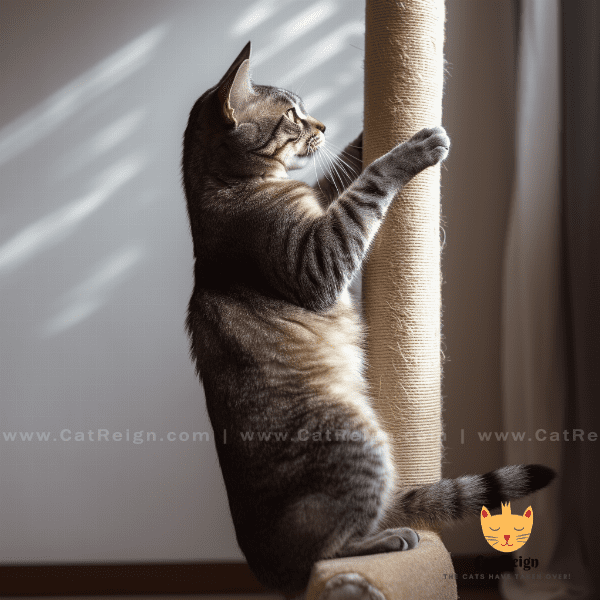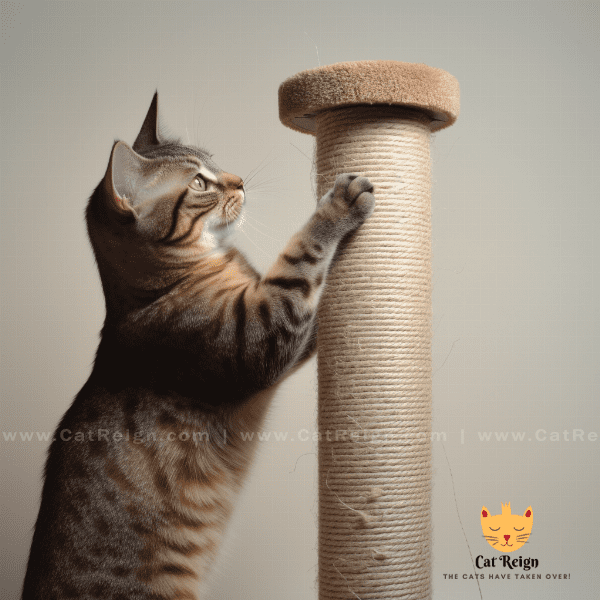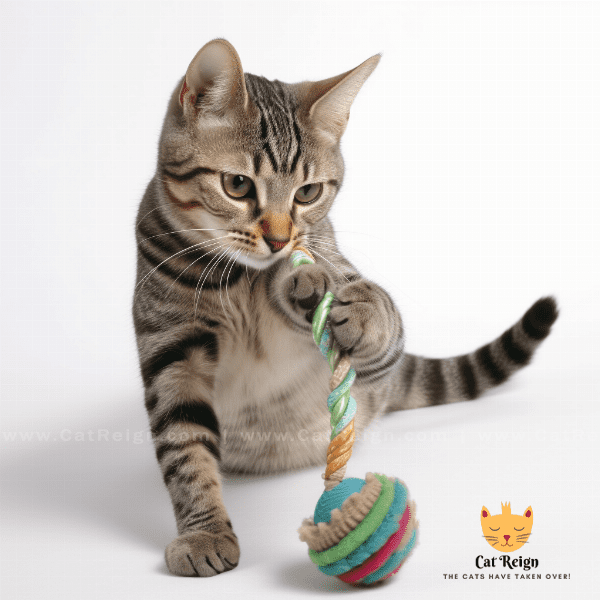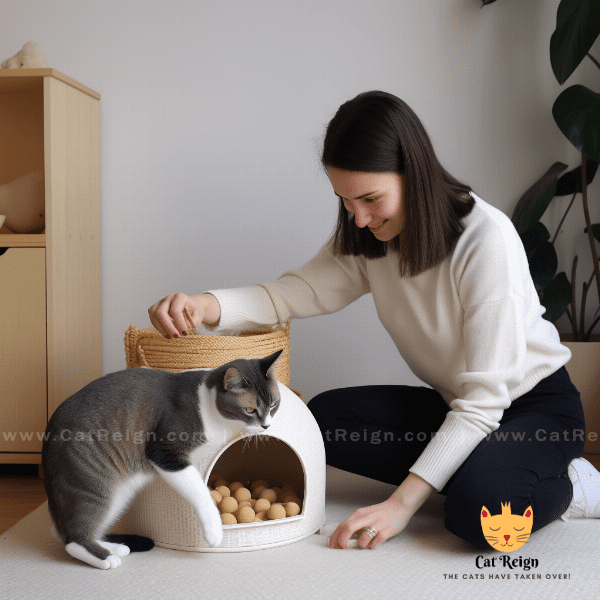Table of Contents
Understanding Feline Behavior
Understanding your cat’s behavior is the first step in addressing their scratching habit. Cats are instinctively territorial and will mark their territory by scratching. It is a natural behavior that they use to stretch their muscles, relieve stress, and remove the outer layer of their claws.
The Role of Playtime
Playtime is essential for cats as it helps them expend energy and stimulates their hunting instincts. Without adequate playtime, cats may become bored and restless, leading to destructive behaviors such as scratching. Providing your cat with interactive toys and play sessions can help prevent excessive scratching.
The Influence of Environment
Cats are sensitive to their surroundings and may exhibit unwanted behaviors if they feel threatened or uncomfortable in their environment. Changes in routine, new people, or other animals can trigger a stress response, leading to excessive scratching. Creating a calm and comfortable environment for your cat can help alleviate stress and reduce unwanted behavior.
The Impact of Health Issues
If your cat’s scratching habit suddenly becomes excessive, it may be due to an underlying health issue. Cats may scratch to alleviate pain or discomfort caused by illnesses or injuries. If you notice any changes in your cat’s behavior or scratching habits, it is essential to seek veterinary care.
Understanding your cat’s behavior is crucial in finding a solution to their scratching habit. By providing an appropriate environment, adequate playtime, and addressing any health issues, you can help your cat maintain healthy scratching habits while protecting your furniture and belongings.

Reasons Behind Cat Scratching
There are several reasons why cats scratch, and understanding these reasons can help you find the appropriate solutions to redirect their scratching behavior.
Instinctive Behavior
Scratching is a natural behavior for cats. They use their claws to mark their territory, stretch their muscles, and remove the outer layer of their claws. Even if your cat is well-behaved and has plenty of scratching options, they may still exhibit this instinctive behavior.
Attention Seeking
Cats may scratch as a way to get attention. If they feel ignored or neglected, they may scratch furniture or other objects to get your attention. Providing your cat with adequate playtime and attention can help prevent unwanted scratching.
Boredom or Stress
Cats may also scratch out of boredom or stress. If they don’t have enough stimulation or feel stressed, they may turn to scratching as a way to relieve their tension. Providing your cat with plenty of toys, scratching posts, and playtime can help alleviate boredom and stress and reduce unwanted scratching.
Medical Issues
Sometimes, cats may scratch excessively due to underlying medical issues such as allergies or infections. If your cat’s scratching habit suddenly becomes excessive, it is essential to seek veterinary care to rule out any medical problems.
Understanding the reasons behind your cat’s scratching behavior is crucial in finding appropriate solutions. By addressing the root cause of the behavior, you can redirect their scratching habit and promote healthy scratching behavior.
 Cat scratching”>
Cat scratching”>Training Techniques for Cats
Positive Reinforcement
Positive reinforcement is a highly effective training technique for cats. Whenever your cat scratches an appropriate surface, reward them with treats, toys, or praise. This positive reinforcement will help your cat associate scratching with a positive outcome and encourage them to repeat the behavior.
Consistent Training
Consistency is key when it comes to training cats. Make sure to consistently redirect your cat’s scratching behavior to appropriate surfaces and reward them for their good behavior. Over time, your cat will learn to associate appropriate surfaces with scratching and avoid inappropriate ones.
Using Deterrents
Deterrents can be useful in preventing unwanted scratching behavior. You can use double-sided tape, aluminum foil, or citronella sprays to deter your cat from scratching inappropriate surfaces. However, it is important to note that deterrents should only be used as a temporary measure and should not be relied on as the sole solution.
Avoiding Punishment
Punishing your cat for scratching inappropriate surfaces can be counterproductive and may even make the behavior worse. Cats respond best to positive reinforcement, and punishment can cause them to become fearful or anxious. Instead of punishing your cat, redirect their behavior to appropriate surfaces and reward them for their good behavior.
Training your cat to scratch appropriate surfaces can take time and patience. By using positive reinforcement, consistency, and avoiding punishment, you can successfully redirect your cat’s scratching behavior and promote healthy scratching habits.

Providing Appropriate Scratching Options
Providing your cat with appropriate scratching options is essential in redirecting their scratching behavior. Here are some effective ways to provide appropriate scratching options for your cat.
Scratching Posts
Scratching posts are one of the most popular options for providing appropriate scratching surfaces for cats. They come in various sizes and materials, including cardboard, sisal rope, and carpet. Place scratching posts in areas where your cat likes to scratch, such as near furniture or in their favorite resting spots.
Scratching Pads
Scratching pads are another great option for cats who prefer horizontal scratching surfaces. They are made of materials such as cardboard or carpet and can be placed on the floor or on furniture to redirect your cat’s scratching behavior.
Cat Trees
Cat trees are a great option for providing your cat with multiple scratching surfaces and other interactive features. They come in various sizes and designs and can provide your cat with a comfortable resting spot, as well as a place to play and scratch.
DIY Options
You can also create DIY scratching options for your cat using materials such as cardboard, carpet remnants, or sisal rope. There are many tutorials and ideas available online for creating customized scratching surfaces that will meet your cat’s needs.
Providing appropriate scratching options is crucial in redirecting your cat’s scratching behavior. By offering a variety of options such as scratching posts, pads, and cat trees, and creating customized DIY options, you can help promote healthy scratching habits for your cat while protecting your furniture and belongings.

Using Deterrents
Deterrents can be useful in preventing your cat from scratching inappropriate surfaces. Here are some effective deterrents that you can use to redirect your cat’s scratching behavior.
Double-Sided Tape
Double-sided tape is a simple and effective way to deter cats from scratching inappropriate surfaces. Cats do not like the sticky sensation of the tape on their paws and will avoid scratching surfaces that have the tape on them.
Aluminum Foil
Cats also dislike the sound and texture of aluminum foil. Placing sheets of foil on surfaces that you want to protect can deter your cat from scratching them.
Citronella Sprays
Citronella sprays can be used as a deterrent for cats who are persistent scratchers. Spraying a small amount of citronella on furniture or other surfaces that you want to protect can discourage your cat from scratching them.
Pet Repellent Sprays
Pet repellent sprays are another option for deterring cats from scratching inappropriate surfaces. They contain natural or synthetic scents that cats find unpleasant and will avoid.
It is important to note that deterrents should only be used as a temporary measure and should not be relied on as the sole solution. Providing appropriate scratching options and training your cat to use them is the best way to redirect their scratching behavior.

Redirecting Attention
Redirecting your cat’s attention can be an effective way to prevent unwanted scratching behavior. Here are some ways to redirect your cat’s attention when they are scratching inappropriate surfaces.
Provide Alternative Activities
Providing your cat with alternative activities can redirect their attention away from scratching. Interactive toys, such as puzzle feeders or laser pointers, can stimulate your cat’s hunting instincts and provide a healthy outlet for their energy.
Engage in Playtime
Engaging in playtime with your cat can also redirect their attention away from scratching. Use toys that your cat enjoys, such as feather wands or string toys, and play with them for at least 15 minutes a day.
Ignore the Behavior
In some cases, ignoring the behavior can be effective in redirecting your cat’s attention. If your cat is scratching an inappropriate surface for attention, ignoring the behavior can cause them to stop. However, it is important to provide alternative activities and positive reinforcement to encourage healthy behavior.
Redirecting your cat’s attention can be a useful tool in preventing unwanted scratching behavior. By providing alternative activities, engaging in playtime, using positive reinforcement, or ignoring the behavior, you can help your cat develop healthy scratching habits while protecting your furniture and belongings.

Handling Aggressive Behavior
Aggressive behavior in cats can be challenging to manage, especially when it comes to scratching. Here are some ways to handle aggressive behavior and prevent scratching incidents.
Recognize the Triggers
Recognizing the triggers that lead to your cat’s aggressive behavior can help you avoid or minimize incidents. Common triggers can include changes in routine, loud noises, or interactions with other animals. Avoiding or minimizing these triggers can reduce your cat’s stress and prevent aggressive behavior.
Establish Boundaries
Establishing boundaries can also help prevent aggressive behavior. For example, if your cat becomes aggressive during playtime, set boundaries by using toys that don’t involve direct physical contact, such as laser pointers or puzzle feeders.
Avoid Punishment
Punishing your cat for aggressive behavior can be counterproductive and may make the behavior worse. Instead of punishment, redirect their behavior to appropriate surfaces or activities, and reward them for good behavior.
Seek Professional Help
If your cat’s aggressive behavior is severe or persistent, it is essential to seek professional help from a veterinarian or animal behaviorist. They can help identify the underlying cause of the behavior and provide guidance on how to manage it effectively.
Handling aggressive behavior in cats can be challenging, but it is essential to prevent scratching incidents and promote a safe and healthy environment for both you and your cat. By recognizing triggers, establishing boundaries, avoiding punishment, and seeking professional help, you can effectively manage your cat’s aggressive behavior and prevent scratching incidents.

Seeking Professional Help
If your cat’s scratching behavior persists despite your best efforts, seeking professional help can be the next step. Here are some ways to seek professional help and address your cat’s scratching behavior.
Consult with a Veterinarian
A veterinarian can help rule out any underlying medical issues that may be contributing to your cat’s scratching behavior. They can also provide guidance on appropriate scratching surfaces, training techniques, and deterrents.
Consult with an Animal Behaviorist
An animal behaviorist can provide more specialized help in addressing your cat’s scratching behavior. They can help identify the root cause of the behavior and provide a personalized plan for addressing it effectively.
Consider Medication
In some cases, medication may be prescribed to help manage your cat’s scratching behavior. Medication can be used to reduce anxiety or stress and can be helpful in conjunction with training and behavior modification techniques.
Make Environmental Changes
In some cases, environmental changes may be necessary to manage your cat’s scratching behavior. This may include changes to your cat’s living space or routine, such as providing additional scratching options or reducing stressors in the environment.
Seeking professional help can be an effective way to manage your cat’s scratching behavior. By consulting with a veterinarian or animal behaviorist, considering medication, and making environmental changes, you can address your cat’s scratching behavior and promote a healthy and happy relationship with your pet.

Creating a Safe Environment
Creating a safe and comfortable environment for your cat can help prevent unwanted scratching behavior. Here are some ways to create a safe environment for your cat.
Provide Adequate Scratching Options
Providing your cat with adequate scratching options can help prevent unwanted scratching behavior. Place scratching posts or pads in areas where your cat likes to scratch, and encourage them to use them by providing positive reinforcement.
Remove Access to Inappropriate Surfaces
Removing access to inappropriate surfaces can also help prevent unwanted scratching behavior. Use deterrents such as double-sided tape or aluminum foil to prevent your cat from scratching furniture or other surfaces that you want to protect.
Make the Environment Comfortable
Cats are sensitive to their environment and may exhibit unwanted behavior if they feel uncomfortable or stressed. Creating a comfortable and calm environment can help reduce stress and promote healthy behavior. Provide comfortable sleeping areas, interactive toys, and opportunities for playtime and exercise.
Use Vertical Space
Cats are natural climbers and enjoy being up high. Providing vertical space such as cat trees or shelves can help satisfy your cat’s need for climbing and provide additional opportunities for scratching.
Ensure Proper Hygiene
Ensuring proper hygiene can also promote a safe and healthy environment for your cat. Regularly clean and sanitize your cat’s litter box, and provide them with fresh water and food daily.
Creating a safe environment for your cat can help prevent unwanted scratching behavior and promote healthy behavior. By providing adequate scratching options, removing access to inappropriate surfaces, making the environment comfortable, using vertical space, and ensuring proper hygiene, you can create a safe and happy environment for your pet.

Building a Stronger Bond with Your Cat
Building a strong bond with your cat can help promote healthy behavior and prevent unwanted scratching incidents. Here are some ways to build a stronger bond with your cat.
Spend Quality Time Together
Spending quality time with your cat can help strengthen your bond and prevent boredom or stress that may lead to unwanted scratching behavior. Make time for daily playtime, cuddling, or grooming sessions.
Provide Affection and Attention
Providing affection and attention can also help strengthen your bond with your cat. Talk to them, pet them, and give them treats to show them that they are loved and valued.
Use Positive Reinforcement
Using positive reinforcement can also help strengthen your bond with your cat. Reward them with treats or praise when they exhibit healthy behavior or perform desired actions.
Learn Your Cat’s Body Language
Learning your cat’s body language can help you understand their needs and communicate effectively with them. Pay attention to their posture, facial expressions, and vocalizations, and respond appropriately to their cues.
Respect Your Cat’s Boundaries
Respecting your cat’s boundaries is crucial in building a strong bond. If your cat wants space or is not in the mood for attention, respect their wishes and give them the space they need.
Building a strong bond with your cat can help prevent unwanted scratching incidents and promote a healthy and happy relationship. By spending quality time together, providing affection and attention, using positive reinforcement, learning your cat’s body language, and respecting their boundaries, you can strengthen your bond and create a safe and loving environment for your pet.




